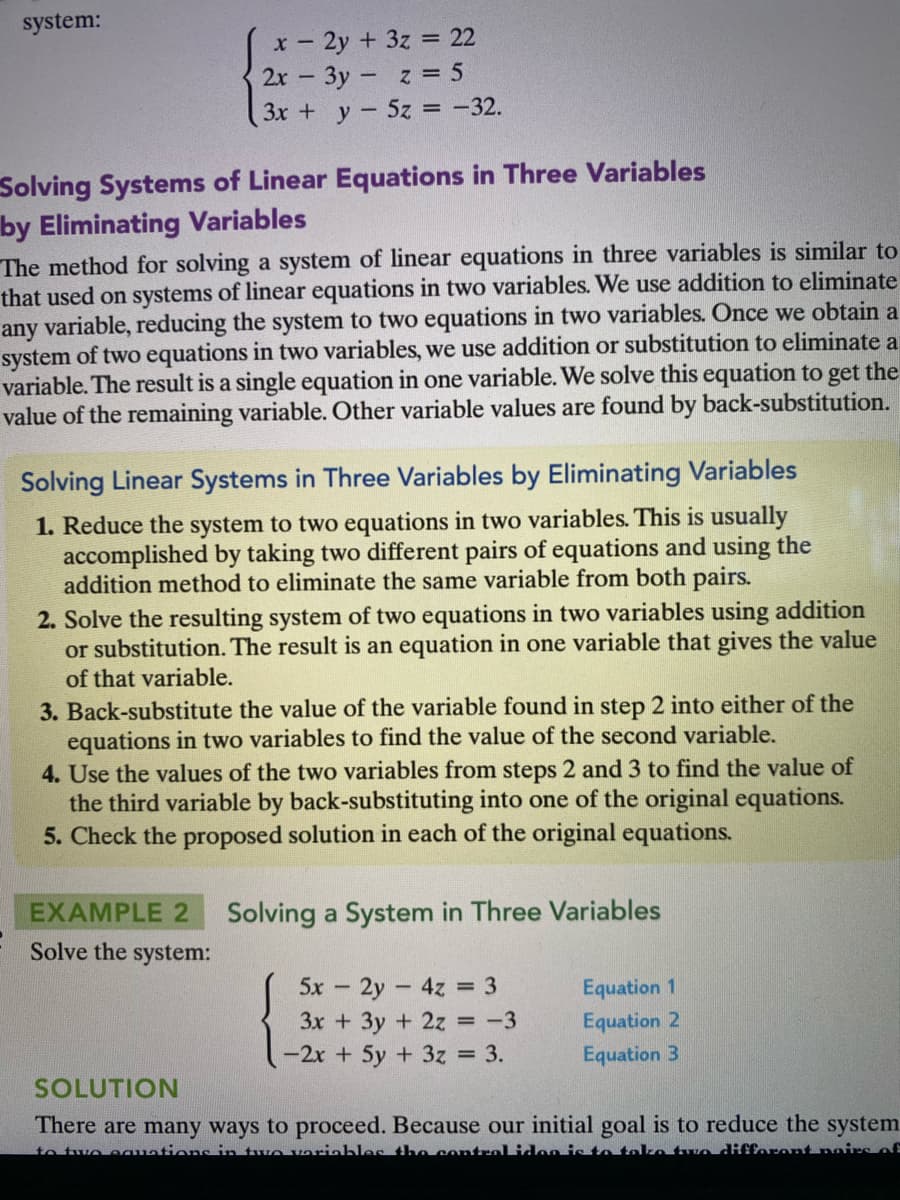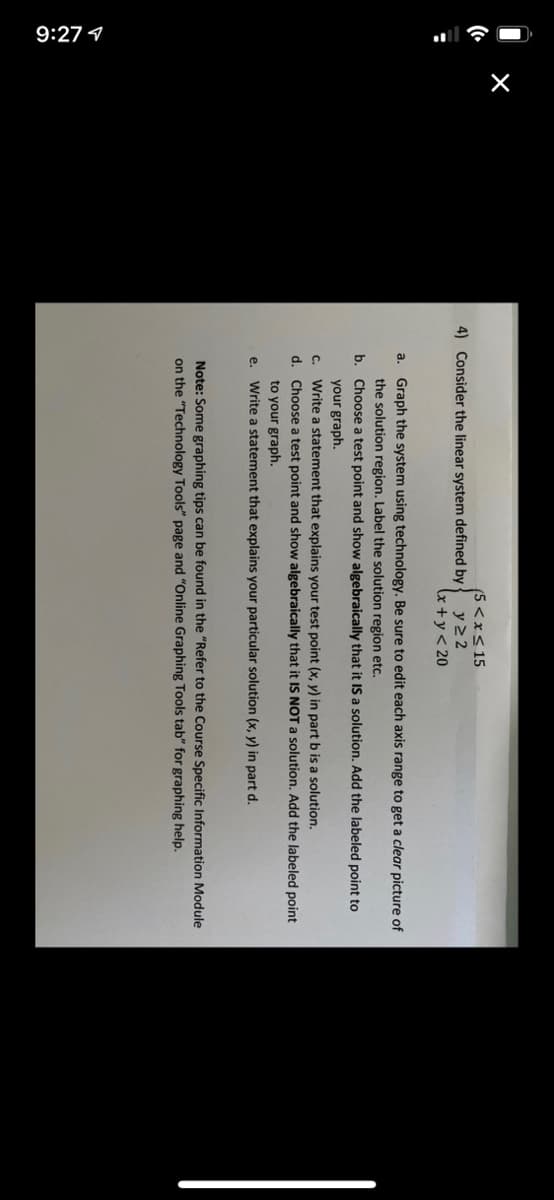E 2 Solving a System in Three Variables stem: 5x 2y 4z = 3 3x + 3y + 2z = -3 -2x + 5y + 3z 3. Equation 1 Equation 2 Equation 3 %3D ON many ways to proceed. Because our initial goal is to reduce ations in tuo voriables the cont lidon is ntoko twn diffor
E 2 Solving a System in Three Variables stem: 5x 2y 4z = 3 3x + 3y + 2z = -3 -2x + 5y + 3z 3. Equation 1 Equation 2 Equation 3 %3D ON many ways to proceed. Because our initial goal is to reduce ations in tuo voriables the cont lidon is ntoko twn diffor
Glencoe Algebra 1, Student Edition, 9780079039897, 0079039898, 2018
18th Edition
ISBN:9780079039897
Author:Carter
Publisher:Carter
Chapter6: Systems Of Linear Equations And Inequalities
Section6.3: Elimination Using Addition And Subtraction
Problem 31PPS
Related questions
Topic Video
Question
100%
Reposting from yesterday’s submission with added information

Transcribed Image Text:system:
x- 2y + 3z = 22
2r 3y z = 5
3x + y-5z = -32.
Solving Systems of Linear Equations in Three Variables
by Eliminating Variables
The method for solving a system of linear equations in three variables is similar to
that used on systems of linear equations in two variables. We use addition to eliminate
any variable, reducing the system to two equations in two variables. Once we obtain a
system of two equations in two variables, we use addition or substitution to eliminate a
variable. The result is a single equation in one variable. We solve this equation to get the
value of the remaining variable. Other variable values are found by back-substitution.
Solving Linear Systems in Three Variables by Eliminating Variables
1. Reduce the system to two equations in two variables. This is usually
accomplished by taking two different pairs of equations and using the
addition method to eliminate the same variable from both pairs.
2. Solve the resulting system of two equations in two variables using addition
or substitution. The result is an equation in one variable that gives the value
of that variable.
3. Back-substitute the value of the variable found in step 2 into either of the
equations in two variables to find the value of the second variable.
4. Use the values of the two variables from steps 2 and3 to find the value of
the third variable by back-substituting into one of the original equations.
5. Check the proposed solution in each of the original equations.
EXAMPLE 2
Solving a System in Three Variables
Solve the system:
5x 2y 4z = 3
3x +3y + 2z = -3
Equation 1
Equation 2
-2x + 5y + 3z = 3.
Equation 3
SOLUTION
There are many ways to proceed. Because our initial goal is to reduce the system.
to two egations in tve variahles the contralidon isto toke tun difforont nairs of

Transcribed Image Text:9:274
(5 <xS 15
y 22
(x +y < 20
4) Consider the linear system defined by
a. Graph the system using technology. Be sure to edit each axis range to get a clear picture of
the solution region. Label the solution region etc.
b. Choose a test point and show algebraically that it IS a solution. Add the labeled point to
your graph.
C. Write a statement that explains your test point (x, y) in part b is a solution.
d. Choose a test point and show algebraically that it IS NOT a solution. Add the labeled point
to your graph.
e. Write a statement that explains your particular solution (x, y) in part d.
Note: Some graphing tips can be found in the "Refer to the Course Specific Information Module
on the "Technology Tools" page and "Online Graphing Tools tab" for graphing help.
Expert Solution
Step 1

Trending now
This is a popular solution!
Step by step
Solved in 2 steps with 2 images

Knowledge Booster
Learn more about
Need a deep-dive on the concept behind this application? Look no further. Learn more about this topic, algebra and related others by exploring similar questions and additional content below.Recommended textbooks for you

Glencoe Algebra 1, Student Edition, 9780079039897…
Algebra
ISBN:
9780079039897
Author:
Carter
Publisher:
McGraw Hill

Algebra for College Students
Algebra
ISBN:
9781285195780
Author:
Jerome E. Kaufmann, Karen L. Schwitters
Publisher:
Cengage Learning

College Algebra
Algebra
ISBN:
9781305115545
Author:
James Stewart, Lothar Redlin, Saleem Watson
Publisher:
Cengage Learning

Glencoe Algebra 1, Student Edition, 9780079039897…
Algebra
ISBN:
9780079039897
Author:
Carter
Publisher:
McGraw Hill

Algebra for College Students
Algebra
ISBN:
9781285195780
Author:
Jerome E. Kaufmann, Karen L. Schwitters
Publisher:
Cengage Learning

College Algebra
Algebra
ISBN:
9781305115545
Author:
James Stewart, Lothar Redlin, Saleem Watson
Publisher:
Cengage Learning

College Algebra (MindTap Course List)
Algebra
ISBN:
9781305652231
Author:
R. David Gustafson, Jeff Hughes
Publisher:
Cengage Learning


Elementary Algebra
Algebra
ISBN:
9780998625713
Author:
Lynn Marecek, MaryAnne Anthony-Smith
Publisher:
OpenStax - Rice University